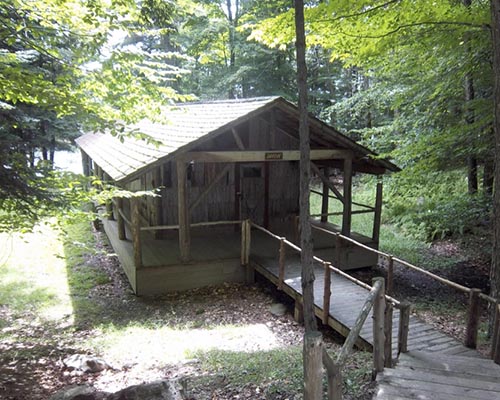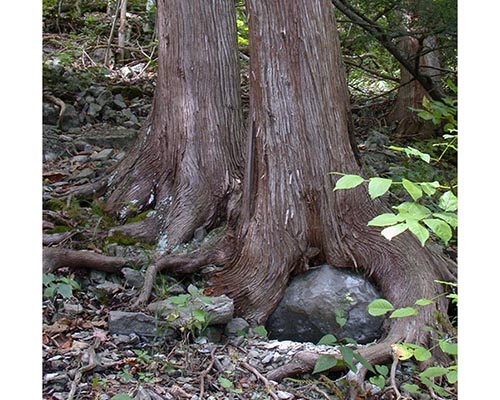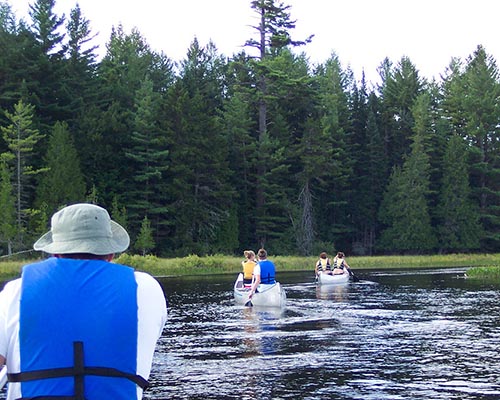Called the Barque of Pine Knot, this houseboat was built by William West Durant as a summer escape for his wife from the black flies. It is not known when the barque was built, but pictures of it exist from as far back as 1885. During summers, it was anchored in Raquette Lake’s South Bay, where Mrs. Durant lived in luxury with two bedrooms, a kitchen, servant’s quarters and bathrooms with flush toilets and pump sinks.
Early Adirondack construction utilized a variety of forest products. The houseboat is paneled with white cedar (Thuja occidentalis) siding. Bark was peeled off cedars in the spring and summer because it was easier to remove at that time of year. It was then soaked in water and flattened to create the siding. Cedar logs were also used as structural posts in the barque, since cedar is rot- and insect-resistant. See if you can spot a white cedar on the trail, with its characteristic vertical bark striations.
The red spruce (Picea rubensis) to the right of the barque’s walkway was also utilized in many early Adirondack buildings. Red spruce siding can be seen at the Chalet at Camp Huntington. White birch (Betula papyifera) was used extensively in canoe-making and indoor decoration; the impressive ceiling of Metcalf Hall at Camp Huntington uses white birch paneling.
What does all this have to do with the name of this station? The term “biomimicry” is derived from the Greek “bios,” meaning life and “mimesis,” meaning imitation. Biomimicry is thus the imitation of life in human-engineered designs. The Adirondacks provide many examples.
The white cedar bark used for siding on the Barque of Pine Knot is strong, durable, insect-resistant and waterproof but most remarkably, it is an excellent insulator. Its microscopic structure consists of thin layers separated by air, like double-pane windows but with many, many panes instead of just two. The texture of the bark also holds a layer of air close to the tree, providing further insulation. This natural design has inspired new types of artificial siding and insulation that cut air-conditioning costs in the summer and heating bills in the winter.
The shape of conifers such as red spruce has also inspired engineers. This shape allows the trees to shed snow. The same idea can be seen in the steep roofs in this area. More surprisingly, this conical shape also traps light and heat, helping coniferous forests to mitigate the cold of winter by funneling the energy of the sun downward even when the sun is low in the sky. This idea has been imitated in the microscopic texturing of silicon to increase solar-cell efficiency; the many conical microstructures on the solar cell’s surface reflect almost no light and thus appear black. This design can also trap sound, which has inspired the cone-shaped wedges on the walls of anechoic chambers, rooms which absorb almost all sound, used in acoustical engineering and the audio industry.
Other examples of biomimicry abound in the Adirondacks. Animals inspire engineers. The iridescence of some insect wings, for example, is leading to new color e-reader displays, and the way snakes move has inspired the development of snake-like robots. Even Velcro imitates the way that seeds of the burdock plant stick using tiny hooks. Evolution has honed its designs for billions of years. As a result, we have a great deal to learn from nature, and every species has the potential to teach us something new and valuable.



